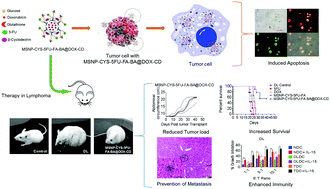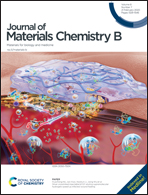Studies on interaction potency model based on drug synergy and therapeutic potential of triple stimuli-responsive delivery of doxorubicin and 5-fluoro-2-deoxyuridine against lymphoma using disulfide-bridged cysteine over mesoporous silica nanoparticles†
Abstract
A triple stimuli-responsive drug delivery platform involving doxorubicin, 5-fluoro-2-deoxy uridine and folic acid was fabricated on mesoporous silica nanoparticles for targeting delivery against a highly aggressive murine lymphoma called Dalton's lymphoma. Fabrication of the unique construct by amalgamating active and passive targeting mechanisms offers a novel hyper-chimeric platform for a stimuli-responsive drug delivery system. The novel construct enables efficient and precise delivery of the precious cargo to the tumor sites. Active targeting by folic acid directs the doxorubicin and 5-fluoro-2-deoxy uridine in the close proximities of the tumor cells, causing efficient killing and significant growth inhibition. Isobologram models, zero interaction potency dose–response surface plots and matrices were generated to evaluate the combination synergism of the two drugs. Therapy with the dual drug-bearing construct in mice with established tumors significantly reduced the tumor load and enhanced the survival of the animals compared with the untreated control. Therapy with the dual delivery system also augmented the innate and adaptive immune defense mechanisms of the treated animals. CD8+ T cells, natural killer cells and the dendritic cells from the treated group following successful therapy with the novel construct showed enhanced cytotoxicity and growth inhibitory capacities against DL tumor cells.



 Please wait while we load your content...
Please wait while we load your content...